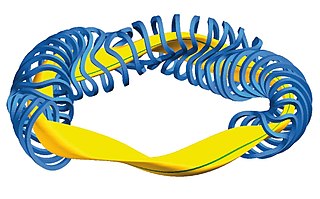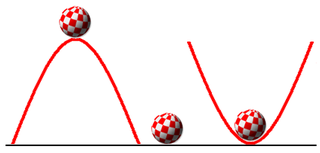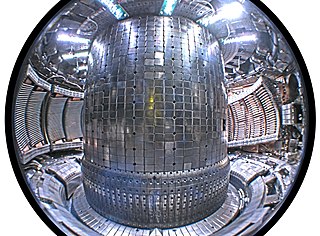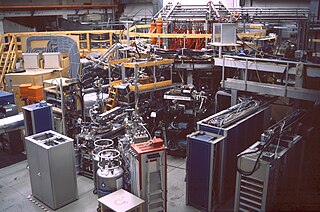Related Research Articles

A stellarator is a plasma device that relies primarily on external magnets to confine a plasma. Scientists researching magnetic confinement fusion aim to use stellarator devices as a vessel for nuclear fusion reactions. The name refers to the possibility of harnessing the power source of the stars, such as the Sun. It is one of the earliest fusion power devices, along with the z-pinch and magnetic mirror.

The stability of a plasma is an important consideration in the study of plasma physics. When a system containing a plasma is at equilibrium, it is possible for certain parts of the plasma to be disturbed by small perturbative forces acting on it. The stability of the system determines if the perturbations will grow, oscillate, or be damped out.

Magnetohydrodynamics is the study of the magnetic properties and behaviour of electrically conducting fluids. Examples of such magnetofluids include plasmas, liquid metals, salt water, and electrolytes. The word "magnetohydrodynamics" is derived from magneto- meaning magnetic field, hydro- meaning water, and dynamics meaning movement. The field of MHD was initiated by Hannes Alfvén, for which he received the Nobel Prize in Physics in 1970.
In particle physics, the particle-in-cell (PIC) method refers to a technique used to solve a certain class of partial differential equations. In this method, individual particles in a Lagrangian frame are tracked in continuous phase space, whereas moments of the distribution such as densities and currents are computed simultaneously on Eulerian (stationary) mesh points.
In physics, Landau damping, named after its discoverer, Soviet physicist Lev Davidovich Landau (1908–68), is the effect of damping of longitudinal space charge waves in plasma or a similar environment. This phenomenon prevents an instability from developing, and creates a region of stability in the parameter space. It was later argued by Donald Lynden-Bell that a similar phenomenon was occurring in galactic dynamics, where the gas of electrons interacting by electrostatic forces is replaced by a "gas of stars" interacting by gravitational forces. Landau damping can be manipulated exactly in numerical simulations such as particle-in-cell simulation. It was proved to exist experimentally by Malmberg and Wharton in 1964, almost two decades after its prediction by Landau in 1946.

Magnetic confinement fusion is an approach to generate thermonuclear fusion power that uses magnetic fields to confine fusion fuel in the form of a plasma. Magnetic confinement is one of two major branches of fusion energy research, along with inertial confinement fusion. The magnetic approach began in the 1940s and absorbed the majority of subsequent development.
A spheromak is an arrangement of plasma formed into a toroidal shape similar to a smoke ring. The spheromak contains large internal electric currents and their associated magnetic fields arranged so the magnetohydrodynamic forces within the spheromak are nearly balanced, resulting in long-lived (microsecond) confinement times without external fields. Spheromaks belong to a type of plasma configuration referred to as the compact toroids.

The Helically Symmetric Experiment, is an experimental plasma confinement device at the University of Wisconsin–Madison, with design principles that are intended to be incorporated into a fusion reactor. The HSX is a modular coil stellarator which is a toroid-shaped pressure vessel with external electromagnets which generate a magnetic field for the purpose of containing a plasma. It began operation in 1999.
Gyrokinetic ElectroMagnetic (GEM) is a gyrokinetic plasma turbulence simulation that uses the particle-in-cell method. It is used to study waves, instabilities and nonlinear behavior of tokamak fusion plasmas. Information about GEM can be found at the GEM web page. There are two versions of GEM, one is a flux-tube version and the other one is a global general geometry version. Both versions of GEM use a field-aligned coordinate system. Ions are treated kinetically, but averaged over their gyro-obits and electrons are treated as drift-kinetic.

Liu Chen is an American theoretical physicist who has made original contributions to many aspects of plasma physics. He is known for the discoveries of kinetic Alfven waves, toroidal Alfven eigenmodes, and energetic particle modes; the theories of geomagnetic pulsations, Alfven wave heating, and fishbone oscillations, and the first formulation of nonlinear gyrokinetic equations. Chen retired from University of California, Irvine (UCI) in 2012, assuming the title Professor Emeritus of physics and astronomy.
John Morgan Greene was an American theoretical physicist and applied mathematician, known for his work on solitons and plasma physics.

In nuclear fusion power research, the plasma-facing material (PFM) is any material used to construct the plasma-facing components (PFC), those components exposed to the plasma within which nuclear fusion occurs, and particularly the material used for the lining the first wall or divertor region of the reactor vessel.
The index of physics articles is split into multiple pages due to its size.

Harold Grad was an American applied mathematician. His work specialized in the application of statistical mechanics to plasma physics and magnetohydrodynamics.
Vitaly Dmitrievich Shafranov was a Russian theoretical physicist and Academician who worked with plasma physics and thermonuclear fusion research.
Miklos Porkolab (born March 24, 1939) is a Hungarian-American physicist specializing in plasma physics.
Jeffrey P. Freidberg was head of the Nuclear Science and Engineering Department at Massachusetts Institute of Technology from 1997 to 2003. He is currently Professor of Nuclear Science and Engineering (Emeritus) at MIT, and a collaborator at NYU's Courant Institute of Mathematical Sciences. He retired as associate director of MIT Plasma Science and Fusion Center and from his academic duties in 2011. He remained involved in the research activities of the PSFC Theory Group and wrote a new textbook on magnetohydrodynamics theory called Ideal MHD that was published in 2014. He is also author of a book titled Plasma Physics and Fusion Energy first published in 2007, that was based on a series of course notes from MIT graduate courses on plasma physics and fusion energy.
Katherine Ella Mounce Weimer was a research physicist at the Princeton Plasma Physics Laboratory at the Princeton University. She is known for her scientific research in the field of plasma magnetohydrodynamic equilibrium and contribution to stability theory of a magnetically confined plasma.
Jürgen Nührenberg is a German plasma physicist.

Wendelstein 7-AS was an experimental stellarator which was in operation from 1988 to 2002 by the Max Planck Institute for Plasma Physics (IPP) in Garching. It was the first of a new class of advanced stellarators with modular coils, designed with the goal of developing a nuclear fusion reactor to generate electricity.
References
- ↑ "Magneto-Fluid Dynamics Division". NYU. Courant Institute of Mathematical Sciences.
- ↑ "Harold Weitzner Research Publications".
- ↑ "APS Fellow Archive". American Physical Society. (search on year=1981 and institution=New York University)